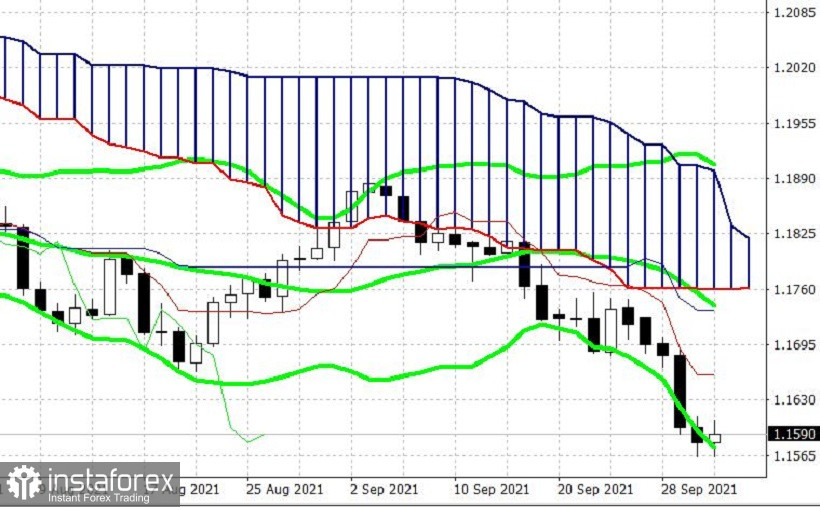The bears of the EUR/USD pair marked a local price bottom, which corresponds to the level of 1.1560 towards the end of the trading week. Traders traded in this price area on Thursday and Friday but did not dare to further decline. The so-called "Friday factor" also played a role: market participants fix profits on the eve of the weekend without risking leaving open positions until Monday. The buyers of EUR/USD took advantage of this and quickly organized a small correction. As a result, the price returned to the borders of the 16th figure after a five-day almost recoilless fall.

The corrective growth of the pair was facilitated by the data on Europe's rising inflation. On Thursday, German inflation surprised with rather weak figures, which for many market participants became a harbinger of a slowdown in pan-European inflation. So, on a monthly basis, the overall consumer price index in Germany in September remained at zero (with a growth forecast of up to 0.3%), and on an annualized basis, the indicator fell short of the forecast values of most experts. The regional reports of the German CPI reflected the widespread deterioration of inflation indicators in monthly terms. Against the background of such inexpressive news from Germany, EUR/USD traders, apparently, were prepared for the fact that the pan-European figures would also not impress them.
However, contrary to pessimistic expectations, Friday's data surprised with a strong result. European inflation surged again, reaching 10-year highs. Thus, the overall consumer price index was at 3.4% in September (after rising to 3.0% in August). Experts expected to see this indicator slightly lower (at the level of 3.3%), but the trend itself is important here, which indicates a consistent and multi-month growth of the indicator. The core index, excluding energy and food prices, jumped to 1.9%.
After a short-term corrective surge, the EUR/USD pair drifted and again found itself under the background pressure of dollar bulls. Traders were not impressed by the record figures of European inflation – just like a month ago, when the CPI showed a similar result. As you know, the new ECB strategy allows for a temporary excess of the inflation target, allowing the regulator to ignore such an inflationary surge. By and large, the European Central Bank has leveled the value of inflation growth in the eurozone, convincing the markets that the regulator will not react to the trends of recent months. This fact further removed the moment of a possible increase in the interest rate. According to ECB representatives, the regulator will raise the rate no earlier than 2024, while some experts talk about the prospects for 2025.
The Fed's position is certainly more hawkish. The probability of the first rate hike in 2022 is growing by leaps and bounds, especially against the background of the energy crisis and ongoing problems in supply chains with very high demand. These factors may push US inflation to another spasmodic growth. At the same time, experts warn market participants about the absence of signs of an early solution to problems in supply chains. Jerome Powell voiced concern about this this week in his speech to Congress.
In general, the Fed will have to solve a difficult puzzle in the form of a conflict between the two main goals of the US Central Bank (inflated inflation against the background of weak labor market growth). Judging by Powell's rhetoric, he hopes for a "natural solution" to the current puzzle, when inflation slows down by itself, largely due to the fact that temporary factors that push inflation up will cease to act. At the same time, some analysts believe that the Fed will have to stop the growth of inflation indicators by raising rates next year.
Jerome Powell, in principle, allowed the possibility of such a scenario. According to him, the US regulator "should consider raising rates if it sees evidence that rising prices are forcing households and companies to expect higher prices to take root, creating more stable inflation."
It is also necessary to recall the results of the last Fed meeting here. According to the updated point forecast, half of the 18 members of the Committee expect an increase in interest rates by the end of 2022. At the same time, according to the results of the June meeting, only seven Fed members did not rule out this scenario – 2023 was the priority at that time.
All this suggests that traders will not abandon the dollar in favor of the euro in the near future, primarily due to the divergence of the ECB and the Fed rates. It is advisable to use any more or less large-scale price increase as an excuse to open short positions: the single currency is still vulnerable, despite the record increase in inflation in the eurozone.

From the technical point of view, the situation is as follows; on the daily chart, the EUR/USD pair is on the lower line of the Bollinger Bands indicator under all the lines of the Ichimoku indicator, which has formed a strong bearish parade of line signal. The first target of the downside movement is the 1.1540 mark (the lower line of the Bollinger Bands indicator coinciding with the lower boundary of the Kumo cloud on the weekly chart). When this target is overcome, the main price barrier will be the 1.1500 mark.






















